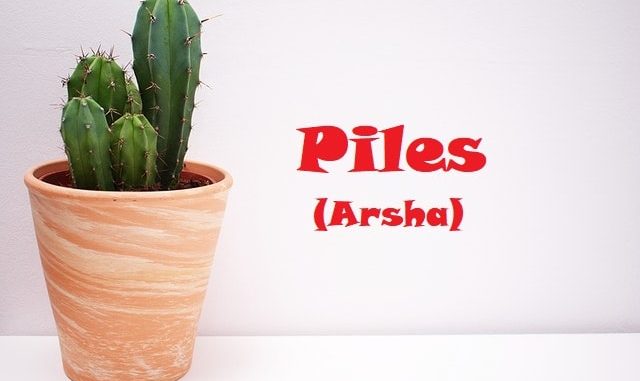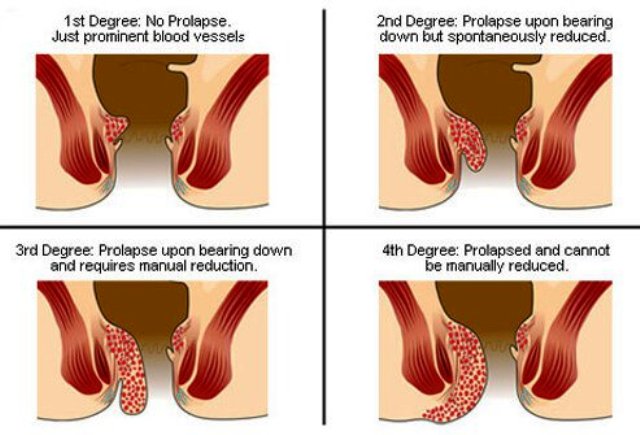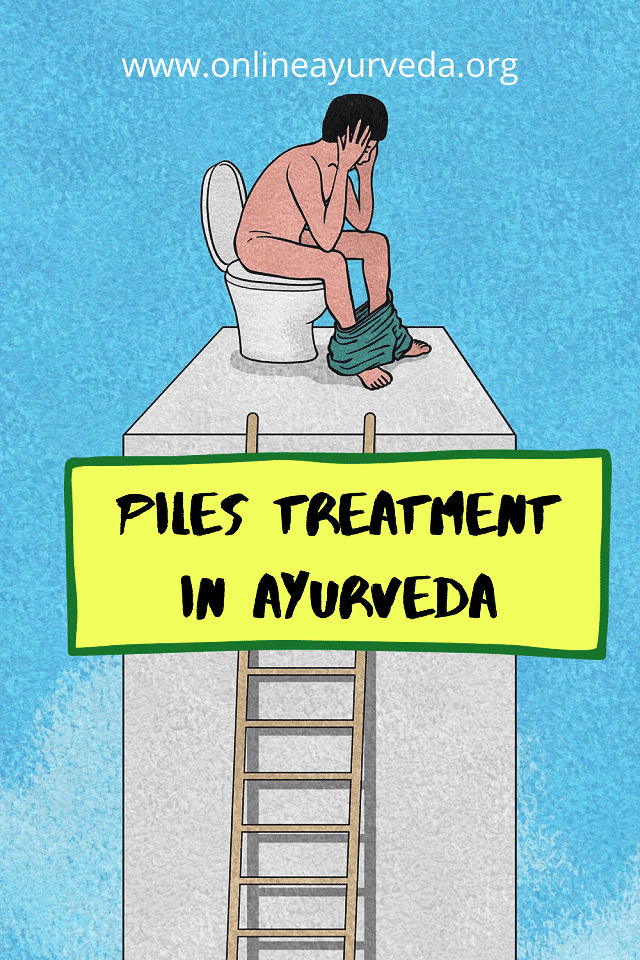
Last Updated on June 16, 2020 by admin
Piles, also known as hemorrhoids in modern science. In Ayurveda, it is called Arsha. It is actually nothing but a dilated vein in the anal canal. When the vein in the anal canal loses its elasticity and becomes loose, it comes out as mass.
Piles can be internal or external according to their presence in and out of the anus. And can be categorized into different degrees according to severeness.

Causes of Piles
- Long sitting at one place.
- Constipation.
- Eating of heavy oily foods.
- Non inclusion of fibers in diet.
- After delivery of baby.
- Injury to the anus.
Symptoms can be seen
- Itching around the anus.
- Swelling and painful and sometimes sticky discharge comes out.
- Bleeding may present during or after defecation.
- Stool may leak.
Treatments of Piles in Ayurveda
In Ayurveda, piles can be treated only by using medicine or by kshara or by kshar sutra surgical procedure.
Classical Formulations:
For Non-bleeding piles
1.Takrarishtha: 10 to 20 ml with equal amount of water can be taken twice daily after food.
2.Abhayarishtha: 10 to 20 ml with equal amount of water twice daily after food.
3.Arshakuthara: 250 to 500 mg thrice daily with Sukumar ghrita before food.
4.Tilabhallataka leha: 1 to 2 table spoon with milk before food.
5.Kasisadi taila: For local application with a cotton cloth.
For Bleeding piles
1.Kutaja ghana vati: 250 to 500 mg thrice daily with sukumar ghrita before food.
2.Bahushala guda: 1 to 2 table spoon with milk before food.
3.Suranadi vati: 250 to 500 mg thrice daily with honey before food.
4.Padmakadi taila: For external application using cotton ball.
Some Branded Formulations made by different companies:
1.Pilex from Himalaya: 1 to 2 tablets thrice daily.
2.Pilief from Charaka: 1 to 2 tablets thrice daily.
3.Sunarin ointment from Phytopharma: for local application.
4.Pilex ointment: for external application.
Ayurvedic Laxatives and Purgatives for constipation:
1.Capsule Herbolax from Himalaya: 1 to 2 tablet at bedtime.
2. Capsule Laxsen: 1 to 2 tablet at bedtime.
3. Tablet Regulax Forte from Charaka: 1 tablet at bedtime.
4. Tablet Myrolax Forte from Dhootapapeshwar: 1 tablet at bedtime.
Kshara(Caustic herbal preparation) Application
This method is very effective for the first and second degrees of piles and external piles. Kshara is nothing but an herbal paste made out of some herbs which burnt ashes are used as a caustic agent.
Herbs which are used generally are apamarga, snuhi, kutaja etc.
Kshara Preparation Method: It is prepared by burning dried apamarga(Achyranthes aspera) parts that are leaves, roots, and shoots. Then the ashes are put in a bowl of hot water. Using a filter paper or cotton, the filtrate is obtained. The filtrate is again filtered for 21 times till a final filtrate is obtained. Then this is again boiled for hours to obtain fine powers or Kshara.
This kshara is locally applied over the piles using a proctoscope and sterile gloves. The kshara is alkaline in nature and works effectively as a caustic agent shedding off the pile mass from the anus.
Kshar sutra(Medicated thread) Application
Kshar Sutra preparation Method: Kshara is the alkaline paste and sutra is the thread that is used to cut off the pile mass. Materials required: Snuhi Kshira(Euphorbia neriifolia latex), Apamarga kshara(Achyranthes aspera ashes powder filtered 21 times as described above), Haridra(Turmeric) powder, Linen thread, Frame to dry the threads and a Kshar sutra cabinet(here the threads will be dried and sterilized using UV light).

After all the materials are ready. Coatings are done on the thread according to the below process. After each coating, the thread is dried in the Kshar sutra cabinet. A total of 21 coatings are done.
Eleven coatings: Snuhi kshira
Seven coatings: Snuhi kshira+Apamarga kshara
Three coatings: Snuhi kshira+ Haridra powder
The medicated thread obtained is used for binding the pile mass and blood supply is cut off. Use to the presence of kshara the mass is easily excised and antiseptic property of Haridra heals the area.
Also Read: Ayurvedic herbs that darken hair
Bael fruit for diabetes and how to consume it
10 Best herbal medicine books to Read in 2020
Ayurvedic Properties and Benefits of Aloe Vera (Kumari)
Lupus and Its Ayurvedic Treatment
What to do and what not to do if you have piles
1.Rest is required and elevation of foot end is prefered.
2.Consume Plenty of fluid in a day.
3.Eat green vegetables, mostly leafy high fiber diet.
4.Take stool softeners like Isabgol(Psyllium husk).
5.Avoid hot spicy oily foods.
Ayurvedic medicinal plants for piles
There are many ayurvedic medicinal herbs for piles. Composition of herbs has shown more effectiveness than single herb. In Ayurveda, there is a group of 10 herbs known as Arshoghna gana. Those are Kutaja, Chitraka, Nagara, Ativisa, Abhaya, Dhanvayasaka, Daru Haridra, Vacha, Chavya.
Few of the herbs that are being used my ayurvedic practitioners-
Kutaja: This herb is one of the important herbs in Ayurvedic medicine. Its scientific name is Holarrhena antidysenterica. Kshara(Ashes) of Kutaja can be applied to bleeding pile mass to reduce the pile mass size.
Haritaki: This herb has anti-inflammatory and antibacterial property which help in healing the pile mass. Haritaki powder also acts as a laxative thereby reducing the pressure on the anal region during defecation.
Kutki: Known scientifically as Picrorhiza kurroa, this herb helps in keeping the liver function at best. The digestive system remains normal and does not allow stool to harden. As there will be no constipation, chances of pile formation minimized.
Nagkesar: It is indicated for all types of bleeding disorders due to its hemostatic quality. Its scientific name is Mesua ferrea. The white flower of Nagkesar is used to reduce pile mass bleeding and swelling which ultimately shrinks the mass.
Chitrak: Plumbago zeylanica act as a laxative and enhances digestion. It can be consumed making a paste of parts of the herb(leaves, roots, flowers) and soaking in curd or milk overnight. It is a great remedy for non-bleeding piles.


Dr please tell about IBD in ayurveda causes and medicine.